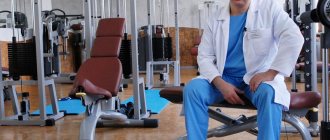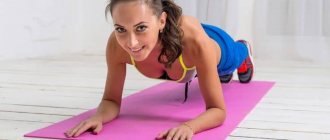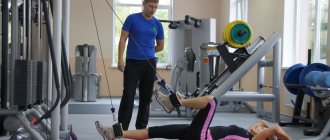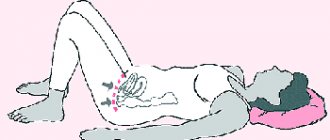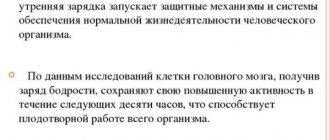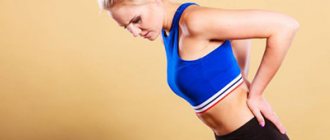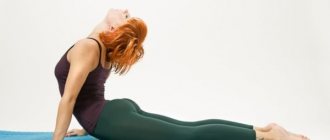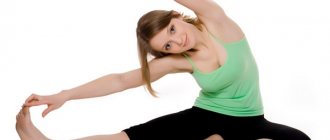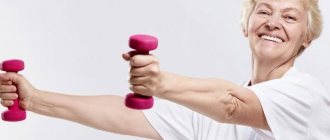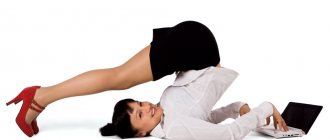The life rhythm of a person living in the 21st century, a sedentary lifestyle, and little physical activity negatively affect his health. Previously, older people mostly complained about osteochondrosis of the cervical spine, but now this problem has become much younger. There are different methods of treating this disease, but the best and most effective way to get rid of pain in the cervical spine is Bubnovsky’s neck gymnastics.
Attention! It is the exercises for the neck of Dr. Sergei Mikhailovich Bubnovsky that doctors recommend to their patients.
Exercises to relieve neck pain
Painful sensations in the neck indicate spasmed muscles. It is necessary to improve blood flow in this area by warming up and stretching the muscle tissue. To perform gymnastics you will need a fitball and an elastic band.
Do the exercises for several days in a row. Perform approaches as many times as possible.
| Initial position | Execution Rules |
| Fasten the tape a little higher in front of you. Sit on the floor. Take the tape by the ends. Place a fitball behind you and lean your shoulders and back on it. | Alternately, as you exhale, bend your elbows, pulling the ends of the elastic band towards you. |
| Sit with your back to the tape attached at the top. Place a fitball behind you. Take the ends of the tape and stretch your arms up. | As you exhale, lower your arms down to your sides while bending your elbows. |
| Same. | Raise and lower your arms straight in front of you. |
| Stand facing the wall at a distance of 50 cm. Rest your hands against the wall at shoulder level and bend them at the elbows, without lifting your heels from the floor. | As you exhale, push off the wall, straightening your arms using the force of your shoulders. Here it is important not to push off with your palms, but to work with your shoulders . |
Disadvantages of the author's methodology
- Due to the lack of intense loads, visible results in strengthening muscles and tendons will appear only after 2 months of regular exercise.
- Since noticeable and lasting results do not appear immediately, the patient’s powerful motivation to practice is important. Not all people have it.
- To choose the right exercises, you need to visit a special center that specializes in treatment and rehabilitation using the methods of Dr. Bubnovsky.
- Some exercises are performed on machines, so they cannot be done at home.
Removing the widow's hump
A fat pad on the neck can form due to a sedentary lifestyle and obesity. It interferes with the normal movement of blood through the vascular bed, restricts muscle movement, which leads to disruption of the connection between muscle tissue and the central nervous system.
| Initial position | Execution Rules |
| Secure a load weighing 20 kg or more to a rope through a ring (you can attach an expander or an elastic band). Get on all fours with your side to the load at a distance of about two meters. Grasp the free end of the rope so that your arm is extended to the side. | · Bend your shoulder to the floor as low as possible without letting go of the load. · Repeat with the other hand. |
| Secure the expander (elastic band) above you. Sit with your back to him, with emphasis on the fitball. | Take the ends of the expander in your hands and alternately swing your arms up and down, stretching the rubber. There is no need to rush - do it gradually, breathe evenly. |
| The starting position is the same. | Swing up and down with both arms at the same time for 3-4 minutes. |
Exercises according to Dr. Bubnovsky for the neck will help remove the widow’s hump.
Introduction
Problems with the cervical spine are quite common, not only in older people, but also in the younger generation. The reason for this is considered to be a sedentary lifestyle, bad habits and genetic predisposition.
However, you can get rid of this disease. For this purpose, many professors and doctors have developed special complex exercises. One of these complexes, called kinesitherapy, is presented by Dr. Bubnovsky.
What is cervical osteochondrosis? This is deformation of the intervertebral discs and degeneration of cartilage tissue. As the disease develops, it gradually destroys connective tissues and discs, resulting in severe pain and even possible loss of ability to work.
Background of the problem:
- flat feet, especially if the patient is overweight;
- injuries or developmental defects of the spine;
- lifestyle - sedentary, or, conversely, physically difficult;
- regular hypothermia of the body;
- violation, curvature of posture;
- specific sport;
- genetics.
Important: deteriorating environmental conditions, bad habits and a sedentary lifestyle contribute to the appearance of osteochondrosis.
How to understand that this particular disease has settled in the cervical spine? The following symptoms should alert you:
- regular severe headache;
- shoulder and back pain;
- decreased muscle strength in the arms;
- chest pain;
- frequent dizziness;
- crunching sounds when turning the head;
- deterioration of visual and auditory functions;
- upward pressure surges.
The benefits of physical education
To maintain health, the body needs physical exercise. All human muscles are usually quite active during the day, so they must be developed and strong. Otherwise, the body may not be able to withstand the load and fail, resulting in guaranteed health problems.
Doctor Shishonin's complex for hypertension
People lead a sedentary lifestyle. Work is often associated with a static position and stress. This affects health - gradual spasms of the cervical muscles occur. They put pressure on the blood vessels, which leads to a lack of blood flow to the brain. The brain does not receive enough oxygen and micronutrients. A person develops migraines and high blood pressure.
Patients do not realize that the cause of their symptoms is muscle spasm in the cervical spine. They try to blame it on fatigue, stress and start taking medications.
Symptoms of cervical spasms
- Decreased concentration and memory.
- Pain in the neck, back.
- Migraine.
- Dizziness.
Exercises for high blood pressure can be done anywhere, even at work. This will take 15-25 minutes. By performing the complex regularly, you can forget about headaches, hypertension and medications.
Indications for implementation:
- Cervical osteochondrosis.
- VSD.
- Migraines and headaches.
- Insomnia.
- Chronic fatigue.
- Deterioration of attention and memory.
A set of exercises according to Bubnovsky for the neck, aimed at reducing the symptoms of hypertension, was developed in his center more than 10 years ago. It is for this reason that it is still called “Bubnovsky’s exercises for hypertension.”
Reviews
Hello. I suffered with the problem of cervical osteochondrosis for more than one year. The doctors healed it completely (zero effect. I came across Dr. Bubnovsky’s technique... At first I was wary, I read a lot of negative reviews, but considering that they were all written like a carbon copy... In general, I decided to try it. I felt the pain subsiding in just a few days).
Natalya Alexandrovna, Ekaterinburg
Thanks to the doctor - man! I’ve been practicing his techniques for many years and I don’t regret the time spent for a minute; I forgot about problems with my neck a long time ago! Thank you!
Vladimir Ivanovich, Rostov region.
- Related Posts
- Gymnastics for the neck for pain due to osteochondrosis, exercises for the withers and computer neck with pictures and videos
- Neck exercises from Dr. Shishonin, description, video, reviews
- A set of exercises for correct straight posture, to open the thoracic spine
« Previous entry
Dr. Shishonin’s complex for cervical spine restoration
Over time, the deep muscles in the neck become tight, which leads to pain in the neck, upper limbs, and the development of constant migraines. The reasons for this are constant stress, sedentary work, and an inactive lifestyle.
The exercises are designed in such a way that they are not capable of causing harm, but performing them regularly will relieve symptoms such as:
- Manifestation of insomnia to any degree.
- Stressful conditions, increased emotional background.
- Overvoltage.
- Deterioration in concentration.
- The appearance of salt deposits in the cervical spine.
- Spasms, pain.
- Headache.
Physical education complex
to stretch and work out the deep muscles of the cervical region, improve blood circulation, strengthen the muscle corset.
| Initial position | Execution Rules |
| Metronome. Stand next to a wall or sit on a chair. Keep your head and back straight. | · Gradually tilt your neck towards your left shoulder, fix it and freeze in this position for 10 seconds. · Repeat this movement, but do it in the other direction (towards the right shoulder). |
| Heron. Sit on a chair and place your hands on your knees. | Lower your arms, then move them back a little and pull your head up. Maintain this position for 30 seconds, then return to the starting position. |
| Goose. Before starting the exercise, stand up straight. Hold your head so that your chin is parallel to the floor. | · Stretch your neck forward so that your chin remains in the same position (there is no need to raise or lower it). · Turn your neck to the left side, lower it down and return to the starting position. In the next approach, repeat the last action in the other direction. |
| Looking to the sky. Same as the previous one. The difference is that you need to stretch your head to the maximum possible distance (however, this must be done slowly and smoothly). | After you turn your neck towards one of your shoulders, fix it in this position for 30 seconds. |
| Frame. Sit on a chair. Place your right hand on the opposite shoulder. Raise your elbow so that it is parallel to the floor. Place your left hand on your knee. | The frame is performed in the same way as the previous exercise: the neck is turned to the right side and fixed in this position for 30 seconds. Movements in the second approach are performed in a mirror projection. |
| Fakir. Raise your arms, bend them slightly at the elbows and clasp them overhead. | Turn your head alternately in both directions and hold for 30 seconds. |
| Spring. Sit up straight. | Tilt your chin slightly, stop and leave your head in this position for 4-6 seconds. Smoothly raise your head, pull your chin first forward and then upward. |
The complex must be performed strictly, following the rules
- For the first two weeks, do the complex daily, then twice a week.
- Keep your back straight; this will allow you to perform the exercises technically correctly, which means effectively.
- Perform the exercises for the first week in front of a mirror to strictly follow the technique and avoid mistakes.
- If severe, sharp pain appears during gymnastics, it is necessary to relieve muscle tension. Mild pain is acceptable.
Dr. A. Shishonin developed a course of gymnastics to work out the spine in the cervical region. It is aimed at:
- Reduced muscle spasm.
- Relieving pain syndrome.
- Improving joint mobility and elasticity of muscle tissue.
- Restoration of blood circulation in the upper section.
For cervical osteochondrosis, gymnastics must be done slowly, fixing each movement for 10-30 seconds.
To conduct classes you will not need equipment or a special room; they can be performed at your workplace or even in the fresh air. The duration is about 20-30 minutes, depending on the number of repetitions.
Life story
My cousin is a successful programmer and loves his job very much. But she has the only (for her brother) disadvantage - the need to spend more than 8 hours a day at the computer. My brother is already over 30, and not long ago he started having problems with his neck. At first there was a feeling of tension, then real pain began - and severe. It was difficult to calm them down; ointments helped little.
As a result, one friend advised his brother to have a simple solution - exercises for the neck according to Bubnovsky! This exercise is perfect for both “athletes” and beginners, that is, people with a sedentary lifestyle. Only 20 minutes of such activities a day literally saved my brother and returned him to normal life!
Now he is a fan of this system. It was partly his experience that inspired me to write this article.
We suggest you familiarize yourself with: Juvenile idiopathic arthritis, oligoarticular variant
It will also be useful for you, dear reader, to familiarize yourself with therapeutic exercises for the spine at the link.
Recommendations by S.M. Bubnovsky
To get the effect of performing neck gymnastics, you must follow the rules developed by S. Bubnovsky:
- Perform the complex only on an empty stomach.
- One complex must last at least 20 minutes to see results.
- You can perform gymnastics regardless of the time of day.
- The load should be such that at the end of the complex the person is sweating.
- Make intensifications while exhaling with the sound “HA”.
- Be sure to take a warm shower after physical activity.
Diet without exercise leads to muscle loss
Over time, such a person develops osteochondrosis, arthrosis and diseases of the cardiovascular system. According to Dr. Bubnovsky, nutrition should be rational:
- Eat foods that have not been processed. Vegetables and fruits contain vitamins and fiber, which lose their beneficial properties when exposed to heat.
- Refusal of canned foods.
- When cooking, use no more than 3 ingredients.
- Replace salt with lemon juice, soy sauce, seasonings. Sugar - for honey, fruit, chocolate.
- Do not drink alcohol or coffee.
- Be sure to drink enough clean water (at least 3 liters per day). The water should not be boiled, but spring water.
According to Dr. Bubnovsky, it is dangerous to come to modern doctors, since they “will either heal with pills or cut something off.” It puts patients on their feet without the use of chemicals, but through correctly calculated loads and movements.
Simple tips for a healthy lifestyle
and prevention of diseases of the musculoskeletal system and vascular system from Bubnovsky S.M.:
- It is necessary to walk 10 thousand steps daily, which is approximately 2 hours of quiet walking. But in the modern pace of life, only pensioners and the unemployed can afford this. Therefore, for very busy people, the advice will be different: 20 minutes of intense walking with a heart rate of 140-145 beats per minute.
- Be sure to organize small physical exercises at work, doing exercises for the cervical spine. Such measures will prevent hypertension, migraines, the development of osteochondrosis and salt deposits in the neck.
- Perform three basic exercises daily: Ten squats, that is, 10 times a day, 10 squats. Be sure to follow the rule: lower as you inhale, rise as you exhale.
- Do a press while lying on the bed and raising your straight legs up. It's better if you can throw them over your head. You need to do it 20-50 times a day. The exercise trains the abdominal wall, stretches the spinal column, and makes the internal organs work.
- Push ups. If there is no preparation, then you can start from a table or wall. You need to do 10 push-ups 5-10 times a day.
Differences between gymnastics according to Dr. Bubnovsky and exercise therapy
- Individual selection of a set of exercises and loads based on preliminary diagnostics allows us to identify pathologies and hidden capabilities of the body.
- Working on deep muscles that are not used during exercise therapy.
- The complex contains: breathing exercises, physical education, massage, cryotherapy.
Indications and contraindications
Gymnastics in this case serves as a preventive measure against diseases of the spinal column, as well as a means of treating existing problems.
Indications for cervical gymnastics are the following factors and painful conditions:
- pinching of the basilar artery;
- salt deposits;
- lack of sports activities and “sitting” work;
- poor neck mobility;
- hypertension;
- frequent migraines;
- osteochondrosis and other problems with the spine.
Like any type of sports activity, such exercises have a number of prohibitions. Contraindications to gymnastics are:
- acute period of illness;
- heat;
- severe pain;
- presence of acute viral infection.
In general, the charging complex has no restrictions either by gender or age.
What will be the result?
Do all these exercises regularly and faithfully, and then you are guaranteed to get the following amazing results:
- the load on the spine will decrease;
- muscles will become stronger;
- pain and severe tension will go away;
- cervical muscle spasm will be eliminated;
- the neck will become more flexible and mobile;
- symptoms of osteochondrosis and other ailments will disappear;
- cerebral blood supply is activated;
- metabolic processes in tissues are activated;
- and the overall quality of life will improve.
Training apparatus
Gymnastics for the neck of the doctor Dr. Bubnovsky is also good to supplement with exercises on simulators. To do this, you need to visit a physical therapy room or a gym equipped with an Evminov device and a Yalovitsyn swing. You also need a special horizontal bar with safety straps, on which you hang upside down, with your feet secured to the crossbar.
If the cervical spine is affected by osteochondrosis, in order to avoid the development of complications, it is forbidden to do hanging. Such a load will lead to disruption of the blood supply to the brain tissue.
At home, you can perform exercises selected by your physical therapy doctor using an expander.
Dr. Bubnovsky’s gymnastics for the cervical spine, when performed regularly for a short period of time, will relieve all negative manifestations of degenerative-destructive changes in the collar area.
general characteristics
Bubnovsky’s technique is a set of trainings that are based on kinesitherapy (a separate direction of physical therapy (physical therapy), based on basic medical disciplines and aimed at the psychophysical well-being of the patient).
Kinesitherapy literally means “motion therapy.” The complex is individual. Some deep muscles (for example, the cervical spine), rarely involved in the exercises of classical physical therapy programs (physical therapy) and in everyday life, are developed thoroughly and purposefully using this technique. The muscle frame is strengthened. In addition, the physical activity of this course is accompanied by breathing exercises, cryotherapy, and massage.
Thanks to Dr. Bubnovsky’s exercises, you can strengthen the muscular frame of the neck
Dr. Bubnovsky created a special simulator for quickly relieving pain and restoring mobility. The simulator is applicable in outpatient settings and is safe. It is a simple design equipped with movable blocks, arches and weights (providing decompression and anti-gravity functions) that relieve stress on the spine. At the same time, the muscles actively work.
Dr. Bubnovsky's centers are located throughout the country. There they teach the technique and order of performing individually selected exercises. After training, the patient does everything at home, which is another advantage of this technique.
Training can be carried out in several modes. A gentle regimen is used for exacerbation of inflammatory processes and severe pain. The recovery mode is suitable for rehabilitation purposes, and the training mode is suitable as additional therapeutic measures.
Peculiarities
How does Dr. Bubnovsky’s technique differ from the classical technique? Let's highlight three key differences:
- The therapeutic gymnastics plan is drawn up strictly individually. The doctor must pay attention to the patient’s health, the intensity of the pain syndrome, take into account the person’s physical capabilities, and so on.
- Using the Bubnovsky technique, you can strengthen a group of muscles in the muscular corset, which, unfortunately, are often not trained when performing classical physical therapy exercises.
- Physical activity is combined with breathing exercises. Dr. Bubnovsky also recommends combining his technique with therapeutic massage.
| Classical physical therapy | Bubnovsky's technique | |
| Safety | High degree of security. Medication may be prescribed along with the exercises. | Treatment using this method is absolutely safe and will not cause any harm. The Bubnovsky method does not use tablets for treating spinal osteochondrosis. But pills often have contraindications and side effects. |
| Therapeutic effect | The cervicothoracic region and lumbar region are treated. | Comprehensive healing of the body. After completing the treatment course, a person will not only get rid of the symptoms of osteochondrosis, but also improve the health of the body as a whole. |
| Duration | The effect of use lasts a long time and does not prevent relapses of the disease. | The effect of use lasts for a long time; This allows not only to cure the disease, but also to prevent relapses of the disease. |
| Versatility | Mild and moderate osteochondrosis can be treated. | It is possible to treat both mild pain in the spine and osteochondrosis in the last stage. Also, using the Bubnovsky method, postoperative recovery can be carried out. |
| Side effects | It has a small number of contraindications and side effects. | It has no side effects or contraindications. In other words, a person of any gender and age can perform simple exercises; even if Dr. Bubnovsky’s gymnastics turns out to be ineffective, the person will not suffer from the side effects of the treatment. |
Despite the fact that Bubnovsky’s technique involves the use of an individual program, some recommendations, exercises and principles are universal. Firstly, exercises according to the method are not an isolated method of treatment: they are combined with classical treatment. The purpose of the technique is to strengthen the muscle corset and ligaments of the cervical region, which will contribute to the main course of treatment and improve the general condition of the patient. If you diligently follow the recommendations, the following results are possible.
- Relieving neck muscle spasms.
- Reducing the load on the axial skeleton.
- Improvement of trophism. Acceleration of excretion of tissue metabolic products.
- Slowing down degenerative processes.
- Reduction of inflammatory processes in tissues.
- Increased performance and quality of life as a result of pain relief.
Thanks to Dr. Bubnovsky’s exercises, the patient’s performance increases, pain and spasms go away
Bubnovsky’s technique does not give instant results. Like any course of treatment aimed at slowing down degenerative processes in the structures of the musculoskeletal system, a set of exercises requires patience and diligence. In addition, stopping only at this technique without self-massage and proper nutrition, which Dr. Bubnovsky recommends in addition to the course, may not give the desired results.
You cannot apply the technique yourself without prescribing a professional selection of an individual program and preliminary training.
For patients with chronic osteochondrosis, kinesitherapy exercises can be performed during exacerbation, but smoothly and with less amplitude. However, any training stops when there is acute pain. An exacerbation should be reported not only to the professional practicing the technique, but also to the attending physician.
